ISM 船舶国际安全管理规则-英文版
- 格式:ppt
- 大小:26.93 MB
- 文档页数:60
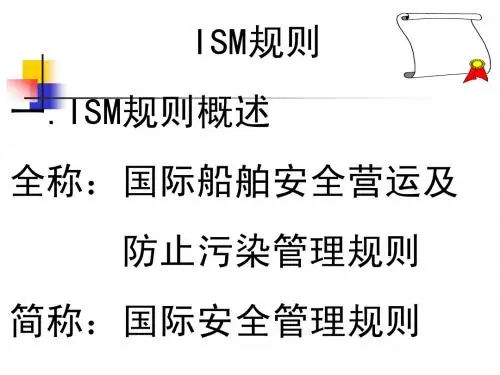
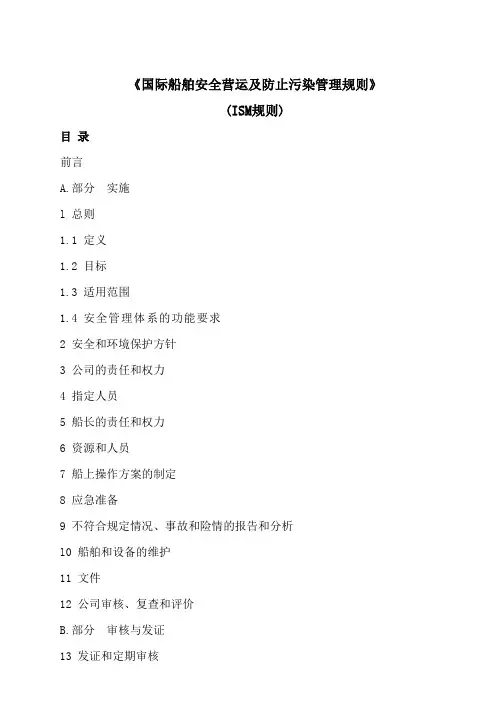
《国际船舶安全营运及防止污染管理规则》(ISM规则)目录前言A.部分实施l 总则1.1 定义1.2 目标1.3 适用范围1.4 安全管理体系的功能要求2 安全和环境保护方针3 公司的责任和权力4 指定人员5 船长的责任和权力6 资源和人员7 船上操作方案的制定8 应急准备9 不符合规定情况、事故和险情的报告和分析l0 船舶和设备的维护11 文件12 公司审核、复查和评价B.部分审核与发证13 发证和定期审核14 核发临时证书15 审核16 证书格式前言1 本规则旨在提供船舶安全管理、安全营运和防止污染的国际标准。
2 大会通过的第A.443(XI)号决议,敬请各国政府采取必要措施,以保证船长在海上安全和保护海洋环境方面正当履行其职责。
3 大会通过的第A.680(17) 号决议,进一步认识到需要建立适当的管理组织,使其能够对船上的某些需求做出反应,以达到并保持安全和环境保护的高标准。
4 认识到航运公司或船舶所有人的情况各异以及船舶操作条件的大不相同,本规则依据一般原则和目标制定。
5 本规则用概括性术语写成,因而具有广泛的适用性。
显然,无论是岸上还是在船上,不同的管理层次对所列条款需要有不同程度的了解和认识。
6 高级领导层的承诺是做好安全管理工作的基础。
就安全和防止污染而言,各级人员的责任心、能力、态度和主观能动性将决定其最终结果。
7 本规则中添加的脚注旨在提供参考与指导,不作为本规则的要求。
然而,按照第1.2.3.2段要求,所有相关指南、建议等均应予以考虑。
考虑到该文献可能已经被修改或更新的资料所取代,任何情况下读者都应使用文件脚注中提到的参考文献的最新版本。
⑤A部分实施○11 总则1.1 定义以下定义适用于本规则的A和B两部分。
○11.1.1 “国际安全管理(ISM)规则”系指由国际海事组织大会通过的,并可由该组织予以修正的“国际船舶安全营运和防止污染管理规则”。
1.1.2 “公司”系指船舶所有人,或已承担船舶所有人的船舶营运责任并在承担此种责任时同意承担本规则规定的所有责任和义务的任何组织或法人,如管理人或光船承租人。
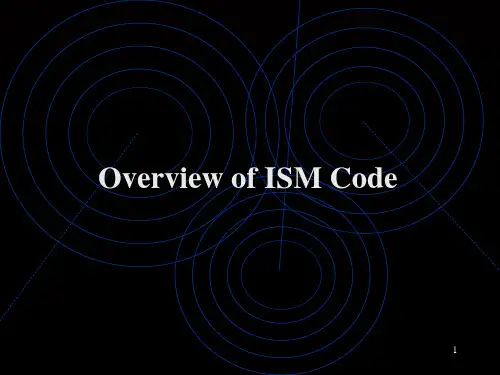
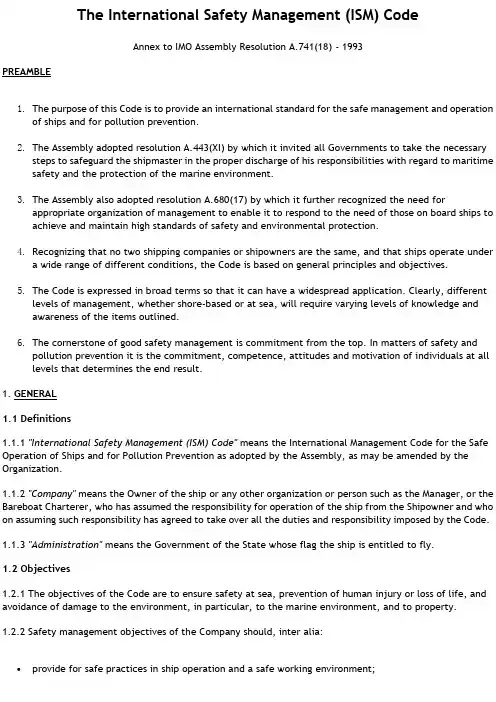
The International Safety Management (ISM) CodeAnnex to IMO Assembly Resolution A.741(18) - 1993PREAMBLE1.The purpose of this Code is to provide an international standard for the safe management and operationof ships and for pollution prevention.2.The Assembly adopted resolution A.443(XI) by which it invited all Governments to take the necessarysteps to safeguard the shipmaster in the proper discharge of his responsibilities with regard to maritime safety and the protection of the marine environment.3.The Assembly also adopted resolution A.680(17) by which it further recognized the need forappropriate organization of management to enable it to respond to the need of those on board ships to achieve and maintain high standards of safety and environmental protection.4.Recognizing that no two shipping companies or shipowners are the same, and that ships operate undera wide range of different conditions, the Code is based on general principles and objectives.5.The Code is expressed in broad terms so that it can have a widespread application. Clearly, differentlevels of management, whether shore-based or at sea, will require varying levels of knowledge and awareness of the items outlined.6.The cornerstone of good safety management is commitment from the top. In matters of safety andpollution prevention it is the commitment, competence, attitudes and motivation of individuals at all levels that determines the end result.1. GENERAL1.1 Definitions1.1.1 "International Safety Management (ISM) Code" means the International Management Code for the Safe Operation of Ships and for Pollution Prevention as adopted by the Assembly, as may be amended by the Organization.1.1.2 "Company" means the Owner of the ship or any other organization or person such as the Manager, or the Bareboat Charterer, who has assumed the responsibility for operation of the ship from the Shipowner and who on assuming such responsibility has agreed to take over all the duties and responsibility imposed by the Code.1.1.3 "Administration" means the Government of the State whose flag the ship is entitled to fly.1.2 Objectives1.2.1 The objectives of the Code are to ensure safety at sea, prevention of human injury or loss of life, and avoidance of damage to the environment, in particular, to the marine environment, and to property.1.2.2 Safety management objectives of the Company should, inter alia:provide for safe practices in ship operation and a safe working environment;∙establish safeguards against all identified risks; and∙continuously improve safety management skills of personnel ashore and aboard ships, including preparing for emergencies related both to safety and environmental protection.1.2.3 The safety and management system should ensure:∙compliance with mandatory rules and regulations; and∙that applicable codes, guidelines and standards recommended by the Organization, Administrations, classification societies and maritime industry organizations are taken into account.1.3 ApplicationThe requirements of this Code may be applied to all ships.1.4 Functional requirements for a Safety Management System (SMS)Every Company should develop, implement and maintain a Safety Management System (SMS) which includes the following functional requirements:∙ a safety and environmental protection policy;∙instructions and procedures to ensure safe operation of ships and protection of the environment in compliance with relevant international and flag State legislation;∙defined levels of authority and lines of communication between, and amongst, shore and shipboard personnel;∙procedures for reporting accidents and non-conformities with the provisions of this Code;∙procedures to prepare for and respond to emergency situations; and∙procedures for internal audits and management reviews.2. SAFETY AND ENVIRONMENTAL PROTECTION POLICY2.1 The Company should establish a safety and environmental protection policy which describes howthe objectives, given in paragraph 1.2, will be achieved.2.2 The Company should ensure that the policy is implemented and maintained at all levels of theorganization both ship based as well as shore based.3. COMPANY RESPONSIBILITIES AND AUTHORITY3.1 If the entity who is responsible for the operation of the ship is other than the owner, the ownermust report the full name and details of such entity to the Administration.3.2 The Company should define and document the responsibility, authority and interrelation of allpersonnel who manage, perform and verify work relating to and affecting safety and pollutionprevention.3.3 The Company is responsible for ensuring that adequate resources and shore based support areprovided to enable the designated person or persons to carry out their functions.4. DESIGNATED PERSON(S)To ensure the safe operation of each ship and to provide a link between the company and those on board, every company, as appropriate, should designate a person or persons ashore having direct access to the highest level of management. The responsibility and authority of the designated person or persons should include monitoring the safety and pollution prevention aspects of the operation of each ship and to ensure that adequate resources and shore based support are applied, as required.5. MASTER'S RESPONSIBILITY AND AUTHORITY5.1 The Company should clearly define and document the master's responsibility with regard to:o implementing the safety and environmental protection policy of the Company;o motivating the crew in the observation of that policy;o issuing appropriate orders and instructions in a clear and simple manner;o verifying that specified requirements are observed; ando reviewing the SMS and reporting its deficiencies to the shore based management.5.2 The Company should ensure that the SMS operating on board the ship contains a clear statementemphasizing the Master's authority. The Company should establish in the SMS that the master has the overriding authority and the responsibility to make decisions with respect to safety and pollutionprevention and to request the Company's assistance as may be necessary.6. RESOURCES AND PERSONNEL6.1 The Company should ensure that the master is:o properly qualified for command;o fully conversant with the Company's SMS; ando given the necessary support so that the Master's duties can be safely performed.6.2 The Company should ensure that each ship is manned with qualified, certificated and medically fitseafarers in accordance with national and international requirements.6.3 The Company should establish procedures to ensure that new personnel and personnel transferredto new assignments related to safety and protection of the environment are given properfamiliarization with their duties. Instructions which are essential to be provided prior to sailing should be identified, documented and given.6.4 The Company should ensure that all personnel involved in the Company's SMS have an adequateunderstanding of relevant rules, regulations, codes and guidelines.6.5 The Company should establish and maintain procedures for identifying any training which may berequired in support of the SMS and ensure that such training is provided for all personnel concerned.6.6 The Company should establish procedures by which the ship's personnel receive relevantinformation on the SMS in a working language or languages understood by them.6.7 The Company should ensure that the ship's personnel are able to communicate effectively in theexecution of their duties related to the SMS.7. DEVELOPMENT OF PLANS FOR SHIPBOARD OPERATIONSThe Company should establish procedures for the preparation of plans and instructions for keyshipboard operations concerning the safety of the ship and the prevention of pollution. The various tasks involved should be defined and assigned to qualified personnel.8. EMERGENCY PREPAREDNESS8.1 The Company should establish procedures to identify, describe and respond to potential emergencyshipboard situations.8.2 The Company should establish programmes for drills and exercises to prepare for emergencyactions.8.3 The SMS should provide for measures ensuring that the Company's organization can respond at anytime to hazards, accidents and emergency situations involving its ships.9. REPORTS AND ANALYSIS OF NON-CONFORMITIES, ACCIDENTS AND HAZARDOUS OCCURRENCES9.1 The SMS should include procedures ensuring that non-conformities, accidents and hazardoussituations are reported to the Company, investigated and analyzed with the objective of improving safety and pollution prevention.9.2 The Company should establish procedures for the implementation of corrective action.10. MAINTENANCE OF THE SHIP AND EQUIPMENT10.1 The Company should establish procedures to ensure that the ship is maintained in conformity withthe provisions of the relevant rules and regulations and with any additional requirements which may be established by the Company.10.2 In meeting these requirements the Company should ensure that:o inspections are held at appropriate intervals;o any non-conformity is reported with its possible cause, if known;o appropriate corrective action is taken; ando records of these activities are maintained.10.3 The Company should establish procedures in SMS to identify equipment and technical systems thesudden operational failure of which may result in hazardous situations. The SMS should provide for specific measures aimed at promoting the reliability of such equipment or systems. These measures should include the regular testing of stand-by arrangements and equipment or technical systems that are not in continuous use.10.4 The inspections mentioned in 10.2 as well as the measures referred to 10.3 should be integrated inthe ship's operational maintenance routine.11. DOCUMENTATION11.1 The Company should establish and maintain procedures to control all documents and data whichare relevant to the SMS.11.2 The Company should ensure that:o valid documents are available at all relevant locations;o changes to documents are reviewed and approved by authorized personnel; ando obsolete documents are promptly removed.11.3 The documents used to describe and implement the SMS may be referred to as the "SafetyManagement Manual". Documentation should be kept in a form that the Company considers mosteffective. Each ship should carry on board all documentation relevant to that ship.12. COMPANY VERIFICATION, REVIEW AND EVALUATION12.1 The Company should carry out internal safety audits to verify whether safety and pollutionprevention activities comply with the SMS.12.2 The Company should periodically evaluate the efficiency and when needed review the SMS inaccordance with procedures established by the Company.12.3 The audits and possible corrective actions should be carried out in accordance with documentedprocedures.12.4 Personnel carrying out audits should be independent of the areas being audited unless this isimpracticable due to the size and the nature of the Company.12.5 The results of the audits and reviews should be brought to the attention of all personnel havingresponsibility in the area involved.12.6 The management personnel responsible for the area involved should take timely corrective actionon deficiencies found.13. CERTIFICATION, VERIFICATION AND CONTROL13.1 The ship should be operated by a Company which is issued a document of compliance relevant tothat ship.13.2 A document of compliance should be issued for every Company complying with the requirementsof the ISM Code by the Administration, by an organization recognized by the Administration or by the Government of the country, acting on behalf of the Administration in which the Company has chosen to conduct its business. This document should be accepted as evidence that the Company is capable of complying with the requirements of the Code.13.3 A copy of such a document should be placed on board in order that the Master, if so asked, mayproduce it for the verification of the Administration or organizations recognized by it.13.4 A Certificate, called a Safety Management Certificate, should be issued to a ship by theAdministration or organization recognized by the Administration. The Administration should, when issuing a certificate, verify that the Company and its shipboard management operate in accordance with the approved SMS.13.5 The Administration or an organization recognized by the Administration should periodically verifythe proper functioning of the ship's SMS as approved.1 总则1.1 定义以下定义适用于本规则的A和B两部分。
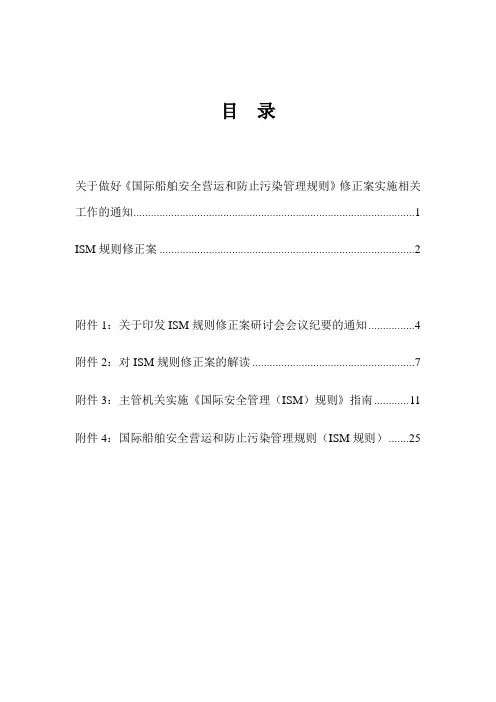
目录关于做好《国际船舶安全营运和防止污染管理规则》修正案实施相关工作的通知 (1)ISM规则修正案 (2)附件1:关于印发ISM规则修正案研讨会会议纪要的通知 (4)附件2:对ISM规则修正案的解读 (7)附件3:主管机关实施《国际安全管理(ISM)规则》指南 (11)附件4:国际船舶安全营运和防止污染管理规则(ISM规则) (25)关于做好《国际船舶安全营运和防止污染管理规则》修正案实施相关工作的通知(中华人民共和国海事局海安全[2009]426号文件,2009年8月4日发布)《国际船舶安全营运和防止污染管理规则》(ISM规则)修正案(附件)已于2008年12月4日在第85届海安会上以第273号决议通过,并将于2010年7月1日起强制实施。
为做好ISM规则修正案实施的相关工作,现将有关事项通知如下:一、各相关国际航运公司应抓紧时间组织研究ISM规则修改的内容,按照修改后的ISM规则在2010年7月1日前完成公司体系文件修改等相关工作。
二、各审核机构、安全管理体系审核员应加强对修改后ISM规则的学习研讨,充分理解掌握ISM规则修正案的精神,自2010年7月1日起主管机关将按照修改后的ISM规则对公司进行发证。
ISM规则修正案MSC.273(85)号决议(2008年12月4日)1 总则1.1 定义1 1.1.10中“包括”改为“或”。
修改后1.1.10叙述为“重大不符合规定情况系指对人员或船舶安全构成严重威胁或对环境构成严重危险,并需要立即采取纠正措施的可辨别的背离,或未能有效或系统地实施本规则的要求”。
1.2 目标2 1.2.2.2改为“对其船舶、人员及环境已标识的所有风险进行评估并制定适当的防范措施”。
5 船长的责任和权力3 在5.1.5开头加上“定期”。
修改后叙述为“定期复查安全管理体系并向岸上管理部门报告其存在的缺陷”。
7 船上操作方案的制定4 第7章改为“对涉及人员、船舶安全和防止污染的关键性的船上操作,公司应当制定有关程序、方案或须知包括必要的检查清单。
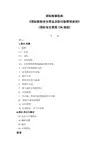
国际海事组织《国际船舶安全营运及防污染管理规则》(国际安全管理ISM规则)目录前言A.部分-实施l 通则1.1 定义1.2 目标1.3 适用范围1.4 安全管理体系(SMS)的基本要求2 安全与环境保护方针3 公司的责任与权限4 指定人员5 船长的责任与权限6 资源与人员7 船上操作计划的制订8 应急部署9 不合格、事故与险情的报告及分析l0 船舶与设备的维护11 文件管理12 公司验证、评审与评估B.部分-发证与验证13 发证与定期验证14 临时审核15 验证16 证书格式前言1 本规则旨在提供一个船舶安全营运及防污染管理的国际标准。
2 大会通过的A.443(XI)决议,请所有政府采取必要步骤保障船长在海上安全及保护海洋环境问题上正当履行其职责。
3 大会还通过A.680(17)决议,进一步认识到需要有适当的管理组织,以满足船上为达到和保持安全和环境保护高标准的需要。
4认识到没有两家航运公司或船东是相同的,而且船舶在处于差异很大的情况下营运,本规则系依据总的原则和目标制订。
5 本规则用概括性术语写,具有广泛的适用性。
显然,不同层次的管理,无论是岸上还是海上,对所列事项将要求不同的知识和了解水平。
6 良好的安全管理基础是领导层的承诺。
安全及防污染方面的最终结果取决于各级人员的承诺、能力、态度和动力。
A.部分-实施1 通则1.1 定义1.1.1国际安全管理(ISM)规则:系指国际海事组织大会通过的,并可由该组织予以修改的《国际船舶安全营运及防污染管理规则》。
1.1.2公司:系指船舶所有人或任何其他机构或个人,诸如管理者或光船租赁人,他们已从船舶所有人处承担船舶经营的责任,并同意承担本规则规定的所有义务和责任。
1.1.3主管机关:系指悬挂该国国旗的国家政府部门。
1.1.4 安全管理体系(SMS):系指能使公司人员有效实施公司的安全及环境保护方针所建立并文件化的体系。
1.1.5 符合证明(DOC):系指颁发给符合ISM规则要求的公司的证明文件。
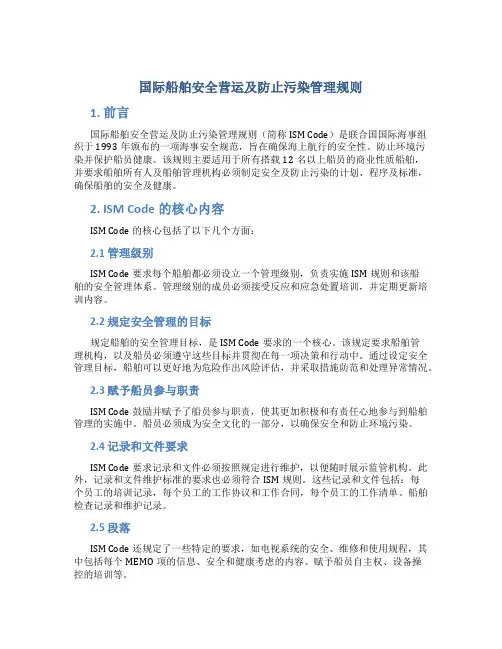
国际船舶安全营运及防止污染管理规则1. 前言国际船舶安全营运及防止污染管理规则(简称ISM Code)是联合国国际海事组织于1993年颁布的一项海事安全规范,旨在确保海上航行的安全性、防止环境污染并保护船员健康。
该规则主要适用于所有搭载12名以上船员的商业性质船舶,并要求船舶所有人及船舶管理机构必须制定安全及防止污染的计划、程序及标准,确保船舶的安全及健康。
2. ISM Code的核心内容ISM Code的核心包括了以下几个方面:2.1 管理级别ISM Code要求每个船舶都必须设立一个管理级别,负责实施ISM规则和该船舶的安全管理体系。
管理级别的成员必须接受反应和应急处置培训,并定期更新培训内容。
2.2 规定安全管理的目标规定船舶的安全管理目标,是ISM Code要求的一个核心。
该规定要求船舶管理机构,以及船员必须遵守这些目标并贯彻在每一项决策和行动中。
通过设定安全管理目标,船舶可以更好地为危险作出风险评估,并采取措施防范和处理异常情况。
2.3 赋予船员参与职责ISM Code鼓励并赋予了船员参与职责,使其更加积极和有责任心地参与到船舶管理的实施中。
船员必须成为安全文化的一部分,以确保安全和防止环境污染。
2.4 记录和文件要求ISM Code要求记录和文件必须按照规定进行维护,以便随时展示监管机构。
此外,记录和文件维护标准的要求也必须符合ISM规则。
这些记录和文件包括:每个员工的培训记录,每个员工的工作协议和工作合同,每个员工的工作清单、船舶检查记录和维护记录。
2.5 段落ISM Code还规定了一些特定的要求,如电视系统的安全、维修和使用规程,其中包括每个MEMO项的信息、安全和健康考虑的内容、赋予船员自主权、设备操控的培训等。
3. ISM Code的实施ISM Code的实施主要有以下几个步骤:3.1 制定安全管理体系计划ISM要求船舶所有者要在船上制定安全管理计划(Safety Management System Plan),并在其船舶承包人或管理人中指定ISM系统负责人。

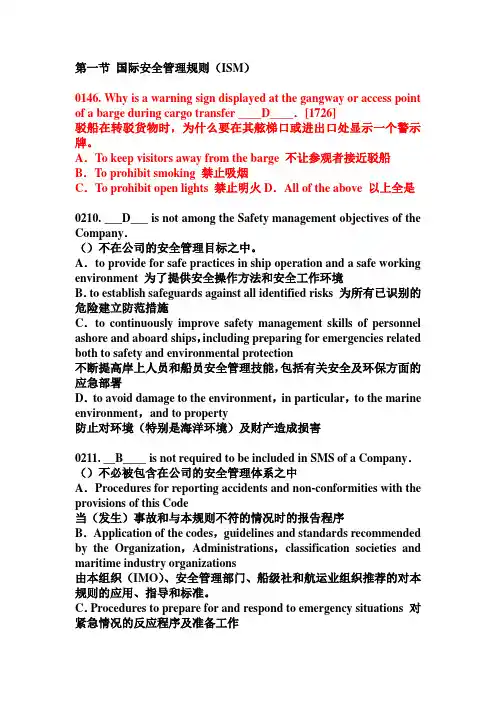
第一节国际安全管理规则(ISM)0146. Why is a warning sign displayed at the gangway or access point of a barge during cargo transfer ____D____.[1726]驳船在转驳货物时,为什么要在其舷梯口或进出口处显示一个警示牌。
A.To keep visitors away from the barge 不让参观者接近驳船B.To prohibit smoking 禁止吸烟C.To prohibit open lights 禁止明火D.All of the above 以上全是0210. ___D___ is not among the Safety management objectives of the Company.()不在公司的安全管理目标之中。
A.to provide for safe practices in ship operation and a safe working environment 为了提供安全操作方法和安全工作环境B.to establish safeguards against all identified risks 为所有已识别的危险建立防范措施C.to continuously improve safety management skills of personnel ashore and aboard ships,including preparing for emergencies related both to safety and environmental protection不断提高岸上人员和船员安全管理技能,包括有关安全及环保方面的应急部署D.to avoid damage to the environment,in particular,to the marine environment,and to property防止对环境(特别是海洋环境)及财产造成损害0211. __B____ is not required to be included in SMS of a Company.()不必被包含在公司的安全管理体系之中A.Procedures for reporting accidents and non-conformities with the provisions of this Code当(发生)事故和与本规则不符的情况时的报告程序B.Application of the codes,guidelines and standards recommended by the Organization,Administrations,classification societies and maritime industry organizations由本组织(IMO)、安全管理部门、船级社和航运业组织推荐的对本规则的应用、指导和标准。
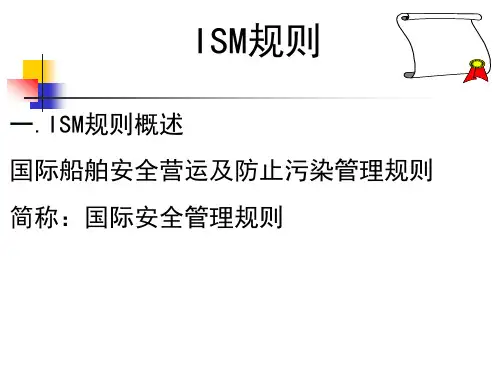
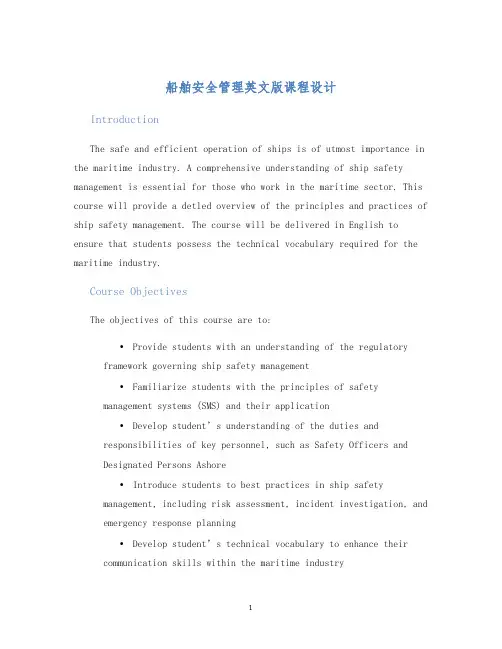
船舶安全管理英文版课程设计IntroductionThe safe and efficient operation of ships is of utmost importance in the maritime industry. A comprehensive understanding of ship safety management is essential for those who work in the maritime sector. This course will provide a detled overview of the principles and practices of ship safety management. The course will be delivered in English to ensure that students possess the technical vocabulary required for the maritime industry.Course ObjectivesThe objectives of this course are to:•Provide students with an understanding of the regulatory framework governing ship safety management•Familiarize students with the principles of safety management systems (SMS) and their application•Develop student’s understanding of the duties a nd responsibilities of key personnel, such as Safety Officers andDesignated Persons Ashore•Introduce students to best practices in ship safety management, including risk assessment, incident investigation, and emergency response planning•Develop student’s technical vocabulary to enhance their communication skills within the maritime industryCourse OutlineUnit 1: Introduction to Ship Safety Management•Overview of the international regulatory framework governing ship safety management•Maritime Safety Management Systems (SMS)•The role and responsibilities of key personnel in safety management•Implementation of the SMSUnit 2: Best Practices in Ship Safety Management•Risk assessment and management•Incident investigation and analysis•Emergency response planning and management•Safety performance monitoring and improvementUnit 3: Case Studies and Group Projects•Analyzing real-life case studies of ship safety incidents•Conducting group projects to develop safety management plans for hypothetical scenariosTeaching Methods•Lecture-based presentations•Group discussions and case study analysis•Guest speakers from the maritime industry•Group projects and individual assignmentsAssessment•Mid-term and final exams•Group projects and individual assignments•Class participation and attendanceConclusionUpon completing this course, students will have a solid understanding of ship safety management principles and practices. They will be able to apply the knowledge they have gned to improve the safety and efficiency of maritime operations. Students will also possess the technical vocabulary required to communicate effectively within the maritime industry.。
船舶安全管理英文版教学设计一、教学目标1.理解船舶安全管理的概念、意义和重要性。
2.掌握船舶安全管理的主要内容和要求。
3.掌握船舶安全管理的相关法规和标准。
4.能够运用所学知识,落实船舶安全管理工作。
5.培养学生具备船舶安全意识和安全管理能力。
二、教学内容1. 船舶安全管理概述1.1 船舶安全管理的概念和意义 1.2 船舶安全管理的发展历程 1.3 船舶安全管理的主要内容和要求2. 船舶安全管理法规和标准2.1 SOLAS公约及附则 2.2 ISM规则 2.3 ISPS规则 2.4 其他相关法规和标准3. 船舶安全管理实施3.1 船舶安全文化建设 3.2 安全管理体系建设 3.3 安全教育和培训 3.4 事故调查和处理 3.5 船舶维护和检查4. 船舶安全管理案例分析4.1 船舶火灾事故案例分析 4.2 船舶碰撞事故案例分析 4.3 其他船舶安全管理案例分析三、教学方法1.讲授法:通过理论讲解、案例分析等方式,介绍船舶安全管理的知识和实施方法。
2.互动式教学:通过小组讨论、角色扮演等互动方式,加深学生对船舶安全管理概念的理解; 3.现场实践:在实践基地对学生进行实际操作和检查维护,探讨不同类型船舶的安全管理措施。
四、教学评估1. 成绩评估成绩评估包括平时表现、作业、期中考试、期末考试等方面。
2.实践成绩评估实践成绩评估包括在船舶上的实际操作和检查维护成绩。
五、教学要求1.要求学生认真听课,课后及时复习;2.要求学生按时完成作业和考试任务;3.要求学生具备一定的英语读写能力,能够阅读英文文献资料;4.要求学生具备一定的航海专业基础知识。
六、教材及参考书目1. 教材船舶安全管理实务(英文版) Ship Safety Management(英文版)2. 参考书目1.船舶安全管理制度识别与建立(英文版)2.船上事故案例分析(英文版)3.船舶维护修理(英文版)。
ISM规则是保证海上安全,防止人员伤亡,避免对海洋环境和财产的伤害。
The ISM rule promises a sea safety, prevent froming personnel's dead and injured, avoiding the injury toward the ocean environment and the property.我们打算明天修理增压器,根据你们的情况介绍,增压器的气封和轴承需换新,由于气封漏泄严重,滑油变质We intend to fix to increase to press a machine tomorrow, according to your circumstances introduction, the spirit which increases to press a machine seals and the bearings need to be changed lately, because the spirit seals to leak to leak severity, slipping oil to change in character滑油柜液位的变化,在某种程度上显示出柴油机的滑油耗量,如油柜液位上升,表明漏水入油柜,柴油机废气温度相同,表明各缸发出的功率相同。
Oil level of the oil tank, display the oil of diesel engine to consume quantity on a certain degree, if the oil level rises, expressing a leak into the oil tank, the temperature of the diesel engine waste gas, express each send out of power .驾机合一是一种先进的船舶控制系统,其特点是集中遥控和自动化程序高。
船舶安全管理英文版课程设计1. Background and PurposeMaritime transportation is an essential component of the global economy, with more than 80% of global trade by volume transported by sea. However, maritime transportation also poses significant safety and environmental risks. To address these risks, the International Maritime Organization (IMO) has established a comprehensive regulatory framework for maritime safety, security, and environmental protection. This framework includes the International Convention for the Safety of Lifeat Sea (SOLAS), the International Convention on Standards of Trning, Certification, and Watchkeeping for Seafarers (STCW), and the International Convention for the Prevention of Pollution from Ships (MARPOL).As a result, maritime professionals need to have a solid understanding of the principles and practices of maritime safety management. This course is designed to provide students with a comprehensive understanding of ship safety management. The course includes both theoretical and practical aspects of ship safety management and provides students with the knowledge and skills necessary to manage safety risks effectively.2. Course Content2.1 Overview of Ship Safety Management•Introduction to the regulatory framework for maritime safety•The roles and responsibilities of the shipowner, master, and crew in ship safety management•The importance of a safety culture on board a ship•Components of a safety management system2.2 Risk Management•Risk assessment: identification of potential hazards•Risk analysis: evaluation of the likelihood and consequences of hazards•Risk control: selection and implementation of control measures2.3 Incident Investigation and Analysis•Incident reporting: importance of reporting incidents and near-misses•Incident investigation: identification of root causes and contributing factors•Corrective and preventive action: implementation of measures to prevent recurrence2.4 Emergency Preparedness and Response•Emergency plans: development, implementation, and testing of emergency plans•Emergency response: roles and responsibilities of the crew in emergency situations•Communication: importance of effective communication in emergency situations2.5 Safety Management System Implementation•Development and implementation of a safety management system on board a ship•Continuous improvement: monitoring and evaluation of a safety management system•Safety audits: importance of internal and external audits3. Learning OutcomesUpon completion of this course, students will be able to:•Understand the regulatory framework for maritime safety and the importance of ship safety management•Identify and evaluate risks on board a ship•Investigate incidents and near-misses and implement corrective and preventive measures•Develop and implement emergency plans and effectively respond to emergency situations•Develop and implement a safety management system on board a ship and continuously improve it4. AssessmentAssessment will be based on a combination of coursework and a final examination. Coursework will include written assignments, group discussion, and case studies. The final examination will test the students’ understanding of the course content.5. ConclusionThis course is designed to provide students with a comprehensive understanding of ship safety management. Upon completion of the course, students will have the knowledge and skills necessary to manage safety risks effectively and will be able to contribute to the development and implementation of safety management systems on board a ship.。
IntroductionShip safety management is critical in the maritime industry. It is essential to ensure the safety of ships, crew, and cargo, as well as the protection of the environment. The safety management of a vessel requires the implementation of appropriate strategies, policies and procedures, and an understanding of the relevant regulations and guidelines. In this tutorial, we will cover the essential elements of ship safety management, including the development of a safety management system, risk assessment, and emergency response planning.Learning ObjectivesThe primary objectives of this tutorial are as follows:•Understand the concept of safety management in the context of the maritime industry•Develop and implement a safety management system for a vessel•Identify and assess potential risks associated with a vessel’s operation•Plan and prepare for emergencies on board a vessel Lesson 1: Introduction to Ship Safety ManagementKey concepts•Safety management in the maritime industry•The International Safety Management (ISM) Code•Safety culture and its importanceLearning activities•Read the relevant sections of the ISM Code and other relevant regulations/ guidelines•Conduct a discussion on the importance of safety culture in the maritime industry•Develop a Safety Policy Statement for a vesselLesson 2: Developing and Implementing a Safety Management SystemKey concepts•The components of a Safety Management System (SMS)•The implementation of a SMS•The role of the Designated Person Ashore (DPA) Learning activities•Develop a SMS for a vessel, including a Risk Assessment and Emergency Response Plan•Assess the effectiveness of an existing SMS and identify areas for improvement•Discuss the responsibilities of the DPA and the importance of effective communication between crew and shore-based personnelLesson 3: Risk Assessment and Emergency Response PlanningKey concepts•The importance of risk assessment and emergency response planning•Methods of risk assessment•The elements of an effective emergency response plan Learning activities•Conduct a risk assessment of a vessel’s operation and identify potential hazards•Develop an Emergency Response Plan for a vessel, including procedures for dealing with different types of emergencies •Conduct an emergency response exercise to test the effectiveness of the planConclusionShip safety management is an essential aspect of the maritime industry. By developing and implementing an effective Safety Management System, assessing and managing risks, and planning for emergencies, we can ensure the safety of our vessels, crew, and cargo. This tutorial has provided an overview of the key concepts and strategies involved in ship safety management, enabling you to develop a solid foundation for safe and efficient vessel operations.。
修改记录Amendment Record安全管理手册目录Index of System Safe Management manual安全管理手册实施声明Statement On Implement SMS (2)前言Preface (4)公司概况Company Brief (4)定义Definitions (4)一总则General (7)二安全和环境保护方针Safety and Environmental Protection Policy (9)三公司的责任和权力Company Responsibility and Authority (11)附件Annex:公司安全管理组织结构图Structure of Safety Management Organization (12)四指定人员Designated Person Ashore (13)关于安全经理授权声明Statement of Authority for Safe Controller (15)五船长的责任和权力Master’s Responsibility and Authority (16)关于船长权力的声明Statement of the Master’ Authority (18)六资源和人员Resources and Personnel (19)七船上操作方案Shipboard Operations (22)八应急准备Emergency Preparedness (24)九对不符合规定的情况、事故和险情的报告和分析Reports and Analysis of Non-Conformities, Accidents and Hazardous Occurrences (26)十船舶和设备的维护Maintenance of Ship & Equipment (28)十一文件管理Documentation Control (31)附件:公司的安全管理体系文件结构Diagram of ISM Document Structure (33)十二公司的审核、复查和评价Company Audit, Review and Evaluation (35)十三发证、审核和监督Certification, Audit and Control (36)十四核发临时证书Issuance of Temporary Certificate (36)十五审核Audit (38)十六证书格式Form of Certificates (38)安全管理手册实施声明Statement On Implement SMS本公司的安全管理体系(SMS)是依据《国际安全管理规则》(ISM CODE)的要求,参照国际海事组织、主管机关、船级社和海运行业组织所建议的适用规则、标准和指南,并结合本公司的实际情况而建立的。